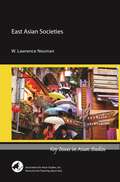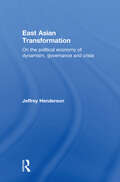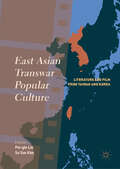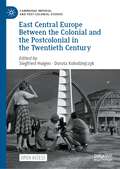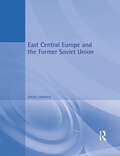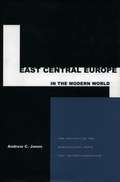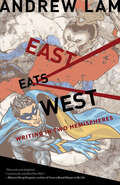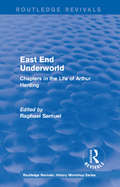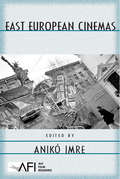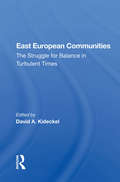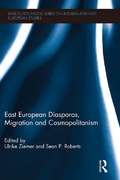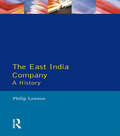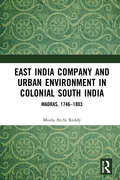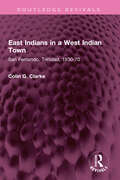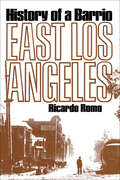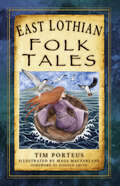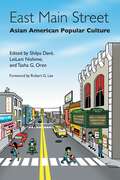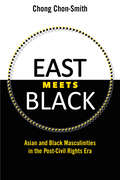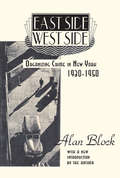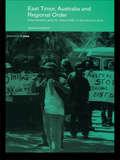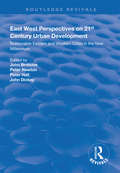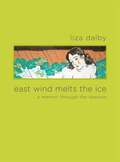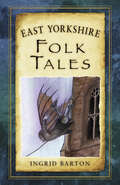- Table View
- List View
East Asian Societies
by W. Lawrence NeumanSo very many teach introductions to East Asia under different disciplines, including the Humanities, Sociology, Economics, History, and Religious Studies, but what makes this work so promising is its transferability across these lines of demarcation for the student engaged in her first serious study of the region. Neuman’s fine overview addresses the recurring cultural tasks across East Asia from family, to school and work, and socio-economic stratifications. Neuman has written an ideal introductory text with a sociologist’s clarity, a humanist’s learning, a researcher’s sharp eye, and a teacher’s fine sense of proportion. This is the only intellectual guidebook you will need to take with you for your voyage to East Asia.
East Asian Transformation: On the Political Economy of Dynamism, Governance and Crisis (International Political Economy Ser.)
by Jeffrey HendersonFrom the re-emergence of Japan as an industrial power in the 1950s through to the contemporary rise of China as a potential economic and political behemoth, the story of East Asian development has been central to any serious analysis of the dynamics and trajectory of the global political economy. Integrated into a coherent, critical narrative, this book examines key political-economic and social dynamics that helped forge the ‘miracle’ economies of East Asia and continue to drive them forward in the volatile circumstances of our current epoch. It analyses the relation between the state and markets; the changing nature of economic governance and its relation to inequality; and the rise of China and its international consequences. Historically informed and comparative in nature, the book contributes to the analysis of the transformations of Japan, Hong Kong, South Korea, Taiwan, Singapore, Malaysia and China, and is the first to cover the ground in one volume. Written by a leading analyst of East Asian development, the book engages with the relevant issues and debates, in an open, non-technical language, making it useful as an advanced textbook not only for East Asian studies, but more generally in international political economy and development studies.
East Asian Transwar Popular Culture: Literature and Film from Taiwan and Korea
by Pei-Yin Lin Su Yun KimThis collection examines literature and film studies from the late colonial and early postcolonial periods in Taiwan and Korea, and highlights the similarities and differences of Taiwanese and Korean popular culture by focusing on the representation of gender, genre, state regulation, and spectatorship. Calling for the “de-colonializing” and “de–Cold Warring” of the two ex-colonies and anticommunist allies, the book places Taiwan and Korea side by side in a “trans-war” frame. Considering Taiwan–Korea relations along a new trans-war axis, the book focuses on the continuities between the late colonial period’s Asia-Pacific War and the consequent Korean War and the ongoing conflict between the two sides of the Taiwan Strait, facilitated by Cold War power struggles. The collection also invites a meaningful transcolonial reconsideration of East Asian cultural and literary flows, beyond the conventional colonizer/colonized dichotomy and ideological antagonism.
East Central Europe Between the Colonial and the Postcolonial in the Twentieth Century (Cambridge Imperial and Post-Colonial Studies)
by Siegfried Huigen Dorota KołodziejczykThis open access book explores the ambiguity of East Central Europe during the twentieth century, examining local contexts through a comparative and transnational reworking of theoretical models in postcolonial studies. Since the early modern period, East Central Europe has arguably been an object of imperialism. However, at the same time East Central European states have been seen to be colonial actors, with individuals from the region often associating themselves with colonial discourses in extra-European contexts. Spanning a broad time period until after the Second World War and covering the governance of Communism and its legacies, the book examines how cultural and literary narratives from East Central Europe have created and revised historical knowledge, making use of collective memory to feed into identity models.
East Central Europe and the Former Soviet Union: Environment and Society
by David TurnockSince 1898, the former communist countries of Eastern Europe have gained international prominence. The continuing socio-economic transition and the instability evident in areas like the Caucasus and Former Yugoslavia have drawn the western world into uneasy interactions with the region. At the same time, closer commercial and cultural contacts are providing opportunities for rewarding relationships which have now resulted in many of these countries joining the EU.This book provides detailed coverage of the transition from communism to a market economy. Covering the whole range of East Central European and former Soviet Union countries, it charts the diversity within the region, offering in-depth coverage of specific areas as well as a broad view of development across the region. The book is organised into three comprehensive sections: the historical, socio-economic and environmental. The socio-economic section considers the critical issues of restructuring to effect the transition from central planning to a market economy, while the historical material provides an essential context for the constraints and opportunities affecting the region. The environmental section places emphasis on results of environmental neglect inherited from communism as well as looking to the future implications of EU directives on the problems of biodiversity and pollution in the region.
East Central Europe in the Modern World: The Politics of the Borderlands from Pre- to Post-Communism
by Andrew C. JanosThrough changes from western liberalism to corrupted parliamentarianism, from fascism to state socialism, and now to capitalist democracy, Janos (political science, U. of California- Berkeley) finds a persistence of challenges in the region's economic backwardness compared with the West, the debilities of small nationhood, and the cultural divide between lands of eastern and western Christianity. He seeks a balance between cultural and economic explanations of conflict, between structural and institutional approaches to politics, and between forces inside and outside society as shapers of power and politics in the states. Annotation c. Book News, Inc., Portland, OR (booknews.com)
East Eats West: Writing in Two Hemispheres
by Andrew LamFrom cuisine and martial arts to sex and self-esteem, East Eats West shines new light on the bridges and crossroads where two hemispheres meld into one worldwide “immigrant nation.” In this new nation, with its amalgamation of divergent ideas, tastes, and styles, today's bold fusion becomes tomorrow's classic. But while the space between East and West continues to shrink in this age of globalization, some cultural gaps remain. In this collection of twenty-one personal essays, Andrew Lam, the award-winning author of Perfume Dreams, continues to explore the Vietnamese diaspora, this time concentrating not only on how the East and West have changed but how they are changing each other. Lively and engaging, East Eats West searches for meaning in nebulous territory charted by very few. Part memoir, part meditation, and part cultural anthropology, East Eats West is about thriving in the West with one foot still in the East.
East Eats West: Writing in Two Hemispheres
by Andrew Lam“Includes some of Lam’s most memorable writings, about cuisine, self-esteem, sex and kung fu, all seen from a two-hemisphere perspective.” —SFGate East Eats West shines new light on the bridges and crossroads where two global regions meld into one worldwide “immigrant nation.” In this new nation, with its amalgamation of divergent ideas, tastes, and styles, today’s bold fusion becomes tomorrow’s classic. But while the space between East and West continues to shrink in this age of globalization, some cultural gaps remain. In this collection of twenty-one personal essays, Andrew Lam, the award-winning author of Perfume Dreams, continues to explore the Vietnamese diaspora, this time concentrating not only on how the East and West have changed but how they are changing each other. Lively and engaging, East Eats West searches for meaning in nebulous territory charted by very few. Part memoir, part meditation, and part cultural anthropology, East Eats West is about thriving in the West with one foot still in the East.“In these lovely, wise, probing essays, Andrew Lam not only illuminates the crucial twenty-first-century issues of immigration and cultural identity but the greater, enduring issues of what it means to be human . . . a compelling book.” —Robert Olen Butler, Pulitzer Prize–winning author “Andrew Lam is an expert time-traveler, collapsing childhood and adulthood; years of war and peace; and the evolution of language in his own life, time, and mind. To read Andrew’s work is a joy and a profound journey.” —Farai Chideya, author of The Episodic Career“One of the best American essayists of his generation.” —Wayne Karlin, author of A Wolf by the Ears
East End Underworld: Chapters in the Life of Arthur Harding (Routledge Revivals: History Workshop Series)
by Raphael SamuelFirst published in 1981, this book examines the life of Arthur Harding, a well-known figure in the East End underworld during the first half of the twentieth century. The first five chapters survey his life in the ‘Jago’ slum between 1887 and 1896, offering a different view of an often vilified district. The subsequent phases of his life as a cabinet-maker, street trader and wardrobe dealer reflect the changing fortunes of the East End from hand-to-mouth conditions in the late-nineteenth century to comparative security in the 1930s. The reader is introduced to some of the major features of East End life — back-street enterprise, neighbourhood solidarity, politics and popular culture. Among the many themes that can be traced are the relationship between the underworld and the local working-class community; the collusive understanding established between villains and the police; the effects of the criminalisation of street betting; and the relationship between Jews, non-Jews and what the author terms ‘half-jews’ in a district of high immigration. Drawn from transcripts of recorded reminiscences, this book provides an important text for understanding the political economy of crime — extended by the authors extensive footnotes and a preface discussing the peculiar moral complexion of south-west Bethnal Green.
East European Cinemas (AFI Film Readers)
by Anikó ImreFirst Published in 2005. Routledge is an imprint of Taylor & Francis, an informa company.
East European Communities: The Struggle For Balance In Turbulent Times
by David A. KideckelThis book focuses on communities in the east European transition and the diverse issues which people face in them on a daily basis. It is organized around three themes: economic change and privatization; the transformation of social and political organization; and changing community belief system.
East European Diasporas, Migration and Cosmopolitanism (BASEES/Routledge Series on Russian and East European Studies)
by Ulrike Ziemer Sean P. RobertsFollowing the demise of the USSR in 1991, and the ensuing collapse of communist regimes in Eastern Europe, widespread population movements took place across Central and Eastern Europe. Whole nations disappeared and (re)-emerged and diasporic transnational ties and belonging have experienced a revival. This book explores some of the many different facets of diasporic life and migration across Central and Eastern Europe by specifically employing the concept of cosmopolitanism. It examines aspects of migrants’ everyday lives and identities, considers some of the difficulties faced by migrant minorities in being accepted and integrated in the host societies, but also examines questions of citizenship and diasporic politics.
East India Company , The: A History (Studies In Modern History)
by Philip LawsonThis is the first short history of the East India Company from its founding in 1600 to its demise in 1857, designed for students and academics. The Company was central to the growth of the British Empire in India, to the development of overseas trade, and to the rise of shareholder capitalism, so this survey will be essential reading for imperial and economic historians and historians of Asia alike. It stresses the neglected early years of the Company, and its intimate relationship with (and impact upon) the domestic British scene.
East India Company and Urban Environment in Colonial South India: Madras, 1746–1803
by Moola Atchi ReddyThis book makes a pioneering attempt to analyse the linkages between the rule of East India Company and urban environment in colonial India over more than a half-century - from 1746 to 1803 - through a study of the city of Madras (present Chennai). The book traces urban development in colonial South India from a broad economic history point of view and with a focus on its environmental dimension, covering the period from the First Carnatic War until the 18th century by which time the English East India Company had consolidated its power. It discusses themes such as urban development; infrastructural development; housing and buildings, city and suburbs; and development of land and roads in the colonial period. Using extensive archival resources, it offers new insights on the various aspects of the shifting urban physical environment and captures the development of Madras city limits; road infrastructure, building of paved streets, whitewashed walls and compounded houses; establishment of garden houses; use of land resources; development of masonry bridges by merchants; housing problems; and the building of Fort House, Garden House, Admiralty House, Pantheon House, Custom House, etc. in Madras, to describe the impact of colonialism on urban environment. An important contribution to the history of urban economics and environment, this book with its lucid style and rich illustrations will be an essential read for scholars and researchers of colonial history, modern Indian history, environmental history, urban environment, urban history, political economy, urban economic history, Indian history, and South Asian studies.
East Indians in a West Indian Town: San Fernando, Trinidad, 1930-70 (Routledge Revivals)
by Colin G ClarkeFirst published in 1986, East Indians in a West Indian Town explores the complex geographical, sociological and anthropological dimensions of Trinidad society before and after its political independence, by employing three sets of materials – census data, questionnaires and participant-observation records. Cartographic, humanistic and statistical approaches are combined in a historical perspective to deal with the significance of race, cultural distinctions and class in San Fernando. A major concern of the book is to examine the social complexity that lies behind geographical patterns, and to compare aggregate data with group behaviour. This book will be of interest to students of geography, sociology and anthropology.
East Los Angeles: History of a Barrio
by Ricardo RomoThis is the story of the largest Mexican-American community in the United States, the city within a city known as "East Los Angeles." How did this barrio of over one million men and women—occupying an area greater than Manhattan or Washington D.C.—come to be? Although promoted early in this century as a workers' paradise, Los Angeles fared poorly in attracting European immigrants and American blue-collar workers. Wages were low, and these workers were understandably reluctant to come to a city which was also troubled by labor strife. Mexicans made up the difference, arriving in the city in massive numbers. Who these Mexicans were and the conditions that caused them to leave their own country are revealed in East Los Angeles. The author examines how they adjusted to life in one of the fastest-growing cities in the United States, how they fared in this country's labor market, and the problems of segregation and prejudice they confronted.
East Los Angeles: History of a Barrio
by Richardo RomoThis is the story of the largest Mexican-American community in the United States, the city within a city known as "East Los Angeles." How did this barrio of over one million men and women—occupying an area greater than Manhattan or Washington D.C.—come to be? Although promoted early in this century as a workers' paradise, Los Angeles fared poorly in attracting European immigrants and American blue-collar workers. Wages were low, and these workers were understandably reluctant to come to a city which was also troubled by labor strife. Mexicans made up the difference, arriving in the city in massive numbers. Who these Mexicans were and the conditions that caused them to leave their own country are revealed in East Los Angeles. The author examines how they adjusted to life in one of the fastest-growing cities in the United States, how they fared in this country's labor market, and the problems of segregation and prejudice they confronted. Ricardo Romo is associate professor of history at the University of Texas at Austin.
East Lothian Folk Tales
by Tim Porteus Donald Smith Mags MacFarlaneStoryteller Tim Porteus brings together stories from the rugged coastlines, golden beaches, rolling countryside and dramatic Lammermuir Hills of the ancient county of East Lothian. In this treasure trove of tales you will meet Scottish Kings and Queens, saints and sinners, witches and wizards, ghosts and giants, fools and tricksters - all as fantastical and powerful as the landscape they inhabit. Retold in an engaging style, and richly illustrated with unique line drawings, these humorous, clever and enchanting folk tales are sure to be enjoyed and shared time and again.
East Main Street: Asian American Popular Culture
by Robert G. Lee LeiLani Nishime Shilpa Davé Tasha G. OrenAn interdisciplinary anthology of the rich Asian American influence on U.S. popular cultureFrom henna tattoo kits available at your local mall to “faux Asian” fashions, housewares and fusion cuisine; from the new visibility of Asian film, music, video games and anime to the current popularity of martial arts motifs in hip hop, Asian influences have thoroughly saturated the U.S. cultural landscape and have now become an integral part of the vernacular of popular culture. By tracing cross-cultural influences and global cultural trends, the essays in East Main Street bring Asian American studies, in all its interdisciplinary richness, to bear on a broad spectrum of cultural artifacts. Contributors consider topics ranging from early Asian American movie stars to the influences of South Asian iconography on rave culture, and from the marketing of Asian culture through food to the contemporary clamor for transnational Chinese women’s historical fiction. East Main Street hits the shelves in the midst of a boom in Asian American population and cultural production. This book is essential not only for understanding Asian American popular culture but also contemporary U.S. popular culture writ large.
East Meets Black: Asian and Black Masculinities in the Post-Civil Rights Era
by Chong Chon-SmithEast Meets Black examines the making and remaking of race and masculinity through the racialization of Asian and black men, confronting this important white stratagem to secure class and racial privilege, wealth, and status in the post-civil rights era. Indeed Asian and black men in neoliberal America are cast by white supremacy as oppositional. Through this opposition in the US racial hierarchy, Chong Chon-Smith argues that Asian and black men are positioned along binaries brain/body, diligent/lazy, nerd/criminal, culture/ genetics, student/convict, and technocrat/athlete--in what he terms "racial magnetism." Via this concept, East Meets Black traces the national conversations that oppose black and Asian masculinities, but also the Afro-Asian counterpoints in literature, film, popular sport, hip-hop music, performance arts, and internet subcultures. Chon-Smith highlights the spectacle and performance of baseball players such as Ichiro Suzuki within global multiculturalism and the racially coded controversy between Yao Ming and Shaquille O'Neal in transnational basketball. Further, he assesses the prominence of martial arts buddy films such as Romeo Must Die and Rush Hour that produce Afro-Asian solidarity in mainstream Hollywood cinema. Finally, Chon-Smith explores how the Afro-Asian cultural fusions in hip-hop open up possibilities for the creation of alternative subcultures, to disrupt myths of black pathology and the Asian model minority. In this first interdisciplinary book on Asian and black masculinities in literature and popular culture, Chon-Smith explores the inspiring, contradictory, hostile, resonant, and unarticulated ways in which the formation of Asian and black racial masculinity has affected contemporary America.
East Side-West Side: Organizing Crime in New York, 1930-50
by William Graham SummerBased on primary source documents, this historical study establishes the interconnections between private violence and political, social, and economic life in New York from 1930-1950. By describing and analyzing both the social world and social system of organized crime, Block provides a new perspective, one based on racial and ethnic stereotypes. The book provides a penetrating look at one of the most misunderstood aspects of American society, important for historians, criminologists and sociologists.
East Timor, Australia and Regional Order: Intervention and its Aftermath in Southeast Asia (Politics In Asia Ser.)
by James CottonThis book explains the exceptional nature of the East Timor intervention of 1999, and deals with the background to the trusteeship role of the UN in building the new polity. All of these developments had an important impact on regional order, not least testing the ASEAN norm of 'non-interference'.Australian complicity in the Indonesian occupation o
East West Perspectives on 21st Century Urban Development: Sustainable Eastern and Western Cities in the New Millennium (Routledge Revivals)
by Peter Hall Peter Newton John Brotchie John DickeyPublished in 1999. Analyzing and chronicling the continued development of key information, communication and fast transport networks at a global and regional level, this book looks at the transition to an information-based economy, and its urban impacts, at a global, regional and city level. The book outlines the change by defining it as the third great societal transition in the history of human settlement, and points to key factors that have fuelled progress. These include the growth of global telecommunications and fast transport networks; the coming together of information and communication technologies and their links to transport and land use; the shift to information and knowledge as a resource base for new industries; the increasing movement of people and information; the emergence of cities as economic entities, network nodes, and centres for generating, exchanging and processing information, and, most significantly, the competition among cities for these new key elements of of the urban economy.
East Wind Melts the Ice: A Memoir through the Seasons
by Liza DalbyWriting in luminous prose, Liza Dalby brings us this elegant and unique year's journal-- a brilliant mosaic that is at once a candid memoir, a gardener's diary, and an enlightening excursion through cultures east and west. In the essays, Dalby transports us from her Berkeley garden to the streets of Kyoto, to Imperial China, to the sea cliffs of Northern California, and to points beyond.
East Yorkshire Folk Tales
by Ingrid BartonEast Yorkshire is ripe with tales of fairy gold and illusive characters. The county’s folklore is engrained in every port, cliff and bridge, passed on through whispered accounts of witches long dead, legends of strange creatures or the bawdy tales of adventuring heroes. Filey Brigg was once a dragon, the people of Skinningrove held a merman captive, and Eskdale’s Beggar’s Bridge holds a love story in its history. By night a mysterious traveller stalked Bowes Moor, with a shrivelled Hand of Glory in his grasp … These engaging stories, brought to life with charming illustrations, will be enjoyed by readers time and again.
